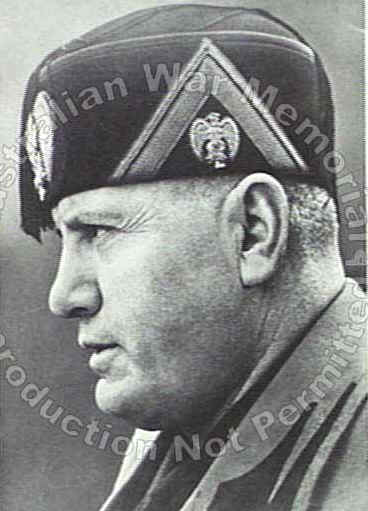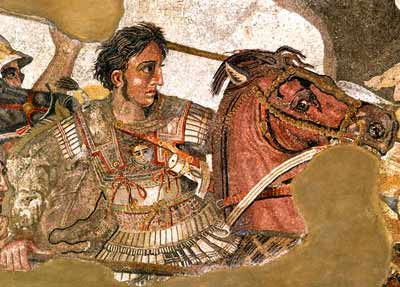 Benito Mussolini
Benito Mussolini
Mussolini's Son Reflects upon his FatherI have not yet read this book, but it seems to have stirred up some controversy concerning the commemoration of
Il Duce.Italian ImperialismThis link contains an article concerning Great Britain, France, and the League of Nations' reaction to Fascist Italy's invasion of Ethiopia in 1935. This topic raises several issues, such as the hypocrisy of Britain and France protesting against another European power conducting imperialism in Africa and the weakness of the League of Nations. The League's inability to prevent Benito Mussolini from annexing Ethiopia in 1935 inspired Adolph Hitler to begin his rampage in Europe in 1938.
Italo-Ethiopian WarI came across an interesting blog that contained an article on the press and the Italian invasion of Ethiopia in 1935. I have recently written an article for a local newspaper on what Fascist Italy's invasion of Ethiopia meant to Italian-Americans in the Philadelphia area. I have found that Fascist Italy's emergence as a world power in the 1930s bolstered Italian-American pride during a time of strong anti-immigrant sentiment in the United States.
Mussolini and South PhiladelphiaThis post touches upon an issue that I wrote about in an article published in
Ciao Philadelphia in the spring of 2006. Click the link above to see the post. My essay is posted below.
Ethiopia was made a part of Benito Mussolini’s “New Roman Empire” in May 1936. This act of imperial aggression was a major step in Fascist Italy’s attempt to solidify its position as a global power. America’s crusade against fascist expansion in the Second World War was a cause for assimilation for many Italian-Americans in 1941, but in 1936 they looked upon Il Duce’s achievements from across the Atlantic with a sense of pride. The “old country’s” rise as a global contender compensated for the lack of respect afforded to them in the United States. Mussolini’s decision to wage war upon a country whose industrial and military capabilities were grossly underdeveloped in comparison to his own, however, marked a turning point in Fascist Italy’s approval around the world. This was especially true in the United States. America’s tolerance for Il Duce was beginning to fade just as Italian-American admiration for the dictator was reaching its pinnacle. The United States government regarded Fascist Italy as an antagonist by the time Mussolini’s army invaded France in June 1940. This placed Italian-Americans in a precarious position, realizing that the day may soon come when they would have to declare their loyalty.
The majority of Italian-Americans who immigrated to the United States prior to Mussolini’s rise to power in 1922 believed in liberal democratic ideals. Many had served in the American Expeditionary Forces during the Great War, and celebrated the United States and Italy’s fight to “make the world safe for democracy.” To them, Il Duce was an autocratic blusterer who deserved little attention as the legitimate representative of Italian political principles and national interests. Italian-American disinterest in Fascist Italy’s affairs was soon reversed by the anti-immigrant sentiments and government policies that were prominent in the United States in the 1920s. The United States government passed immigration legislation in 1924 that placed limits upon the number of Italians that were permitted to enter the country. This law suggested that Italian-Americans were an unwanted minority group, and caused many of them to turn to Fascist Italian nationalism as a source of ethnic pride and camaraderie. Il Duce recognized this as an opportunity to indoctrinate Italian-Americans by importing fascist propaganda to the United States. Establishing a strong fascist contingent in the United States would provide economic and diplomatic support for Mussolini’s militaristic and imperial plans for the future. Of the 129 Italian-American newspapers published in the United States in the early 1930s, eighty endorsed fascism. In Philadelphia, the editor of L’Opione, Filippo Bocchini, ran as a fascist in the congressional election of 1934, the majority of his votes came out of the Italian-American section of South Philadelphia. Italian-Americans proudly listened to Il Duce’s speeches being broadcasted from the Italian consulates in major cities along the east coast. He urged them to gain their citizenship, vote frequently, and introduce fascism into American politics. The Arnaldo Mussolini Educational Center and Lictor Lending Library, named after the dictator’s son, was set up in Philadelphia to promote the preservation of the Italian language. There were 125 Italian-American fascist groups in the United States in 1934 with a total of 500,000 members. Italian-American pride soared in the mid-1930s; identifying with fascism was a part of this phenomena. Mussolini’s global aspirations, however, would soon put Fascist Italy and the United States on a collision course, and alter the lives of Italian-Americans.
The Italo-Ethiopian Crisis began on 30 December 1934 with a confrontation between Italian and Ethiopian soldiers at Wal Wal on the Somali-Ethiopian border. Il Duce demanded an apology from Ethiopian Emperor Haile Selassie, and the payment of $100,000 in reparations. A month later, while Selassie appealed to the League of Nations, Mussolini prepared to invade. President Franklin D. Roosevelt placed an unofficial embargo on Fascist Italy after Italian forces attacked Ethiopia on 3 October 1935. Italian-American newspapers denounced the economic interdiction as an assault on Italian-American pride. On 11 November 1935, Italian-Americans in Philadelphia donned khaki shirts, and marched in support of Mussolini’s war with Ethiopia and the recent bombing of the city of Adowa. Italian-American women donated jewelry to help finance the war effort after the League of Nations placed economic sanctions on Fascist Italy. The Sons of Italy in Philadelphia utilized a local radio station, WRAX, to broadcast speeches by Il Duce’s former Foreign Minister Dino Grandi, and raised over $31,000 for the war. Minister of Press and Propaganda Commendatore Bernardo Bergamaschi was sent to the United States by Mussolini to conduct a $325,000 propaganda campaign. He called upon Italian-Americans to volunteer for military service in Ethiopia; faced with fines, imprisonment, and the loss of American citizenship, 192 Italian-Americans responded to the request. Roosevelt spoke on 3 January 1936 to urge American businesses to observe the unofficial embargo on Fascist Italy, and to propose a revision of the Neutrality Act that would create mandatory sanctions on raw materials. The Sons of Italy and the American League for Italy sent thousands of letters to Congress in protest of the President’s request. By February, Roosevelt’s attention turned to the upcoming election and the importance of Italian-American voters; his motion to amend the Neutrality Act was removed from his agenda. Il Duce’s troops occupied the Ethiopian capital of Addis Ababa on 5 May 1936, and Haile Selassie fled to Great Britain. Italy’s King Victor Emanuel III was crowned Emperor of Ethiopia four days later. Italian-Americans sent telegrams to Italy congratulating Mussolini on his achievement. The Sons of Italy arranged trips to Italy to join the victory celebrations. The ideological complexion of Italian-Americans became a concern for the United States government during the war. The United States government conducted investigations into suspected “fifth column” fascists within the Italian-American community in the late 1930s. Despite this, Italian-American support for Mussolini continued to increase. Italian-Americans believed that Il Duce’s victory in Ethiopia had proven that Fascist Italy was a world power, and therefore elevated their status in American society. A Columbus Day parade in New York City in 1937 featured goose-stepping and fascist salutes.
Mussolini’s affiliation with Hitler became apparent when anti-Semitic laws were passed in Fascist Italy in 1938. This ushered in a transition in Italian-American sentiments toward the dictator. The ties between the two dictators became undeniable on
3 May 1938 when Hitler visited Fascist Italy.
Popular opinion in
America turned sharply against Mussolini after the 1939 Pact of Steel secured a military alliance between Fascist Italy and Nazi Germany. This prompted some prominent Italian-Americans to shift their allegiance. New York City Mayor Fiorello LaGuardia and
Philadelphia restaurant owner Frank Palumbo emerged as leading anti-fascists. Anti-fascist Italian refugees, who had fled to the
United States during the 1930s, were among the most ardent opponents of
Il Duce. Enrico and Laura Fermi and author Max Ascoli sought refuge in the
United States from Mussolini’s anti-Semitic policies and became leading figures in the anti-fascist movement. Anti-fascist Italian-American publications appeared in 1939 and clashed with pro-fascist newspapers.
While this conflict raged in the Italian-American press, Mussolini’s territorial ambition impacted the condition of Italian-Americans once again. The dictator made his fateful decision to follow Hitler into the Second World War by invading
France in time to claim the spoils of victory on
10 June 1940. President Roosevelt announced his support for the Allies in a speech at the
University of Virginia in which he inadvertently offended Italian-Americans just as they were beginning to abandon Mussolini. Roosevelt referred to Fascist Italy’s invasion of
France as “plunging the dagger into the back” of its neighbor. Italian-Americans perceived the metaphor as an ethnic slur. They expressed their displeasure in the 1940 presidential election when Roosevelt lost ten percent of the Italian-American vote in
Philadelphia alone.
Despite their anger over the President’s remarks, Italian-Americans began to distance themselves from fascism. The Fight for Freedom Committee and other radical Italian-American organizations encouraged the
United States to enter the war and free
Italy from
Il Duce’s dictatorship. Many Italian-American newspapers began to publish in English to exhibit their American patriotism. Despite this shift among the majority of the Italian-Americans, some maintained their allegiance to the dictator. The Federation of Italian World War Veterans in
Philadelphia raised $9,000 for Fascist Italy in late 1941. They were among the last Italian-American organizations to continue to endorse
Il Duce. Mussolini alienated himself from the majority of his Italian-American supporters when he declared war on the
United States three days after the Japanese bombed
Pearl Harbor. The degree to which Italian-Americans had assimilated into American society was revealed under the strains of the Second World War. Of the 1.5 million Italian-Americans living in the
United States during the war, only 250 were interned for their fascist sentiments. The most common form of persecution that Italian-Americans faced during the war was the prohibition of the Italian language on the radio.
When Mussolini was deposed on
25 July 1943; there were parades and celebrations in “Little Italys” across
America.
Il Duce had been a symbol of Italian-American pride and the inspiration for maintaining bonds with the “old country” just seven years prior. The transition from immigrants to “hyphenated Americans” for an entire generation of Italian-Americans hinged upon the rise and fall of
Italy’s fascist dictator.
El Alamein FilmI recently purchased a copy of
El Alamein, an Italian film about the Italian Tenth Army's experience in North Africa during the Second World War.



